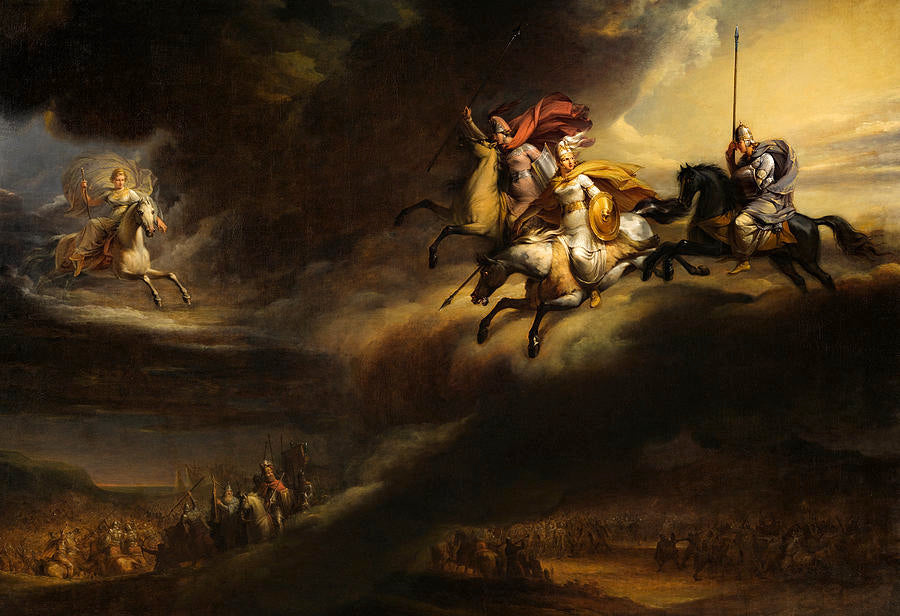Brave warriors who die in battle end up in one of two places. Half go to join the Goddess Freyja hall Sessrúmnir in her realm of Fólkvangr. The other half go to Valhalla, Odin’s hall in Asgard. It’s the job of the Valkyries to choose.

Valhalla, by Max Brückner, 1896.
The name Valkyrie comes from the Old Norse valkyrja, plural valkyrjur, literally “chooser of the slain” (from valr, the slain on the battlefield and kjósa, the verb meaning to choose). Emissaries of the Allfather, Valkyries are beautiful women riding on horses through the skies over a battlefield, choosing amongst the dead the warriors who will join the Einherjar (“army of one”) and feast in Valhalla preparing for the Ragnarok.
Valkyries ride through the air, bear weapons, and can be fierce and beautiful in appearance. Despite what comic books and movies depict, Valkyries do NOT ride winged horses. The Pegasus is the only flying horse in all of the old religions, and he is Greek.
The role of the Valkyrie is, however, more than simply guiding the chosen ones to Valhalla. Valkyries are known to choose who will live or die in the battlefield.

Valkyrie and a Dying Hero by Hans Makart, c.1877.
Valkyries have the power to give victory to one of the warring sides, comparing the clash of two armies in battle to a court where both sides litigate but one party is ultimately given victory by a judge. This metaphor is called “Judgement of Gondul”, and the judge is the Valkyrie.
The expression “Judgement of Gondul” can be traced to the Hákonarmál (The Song of Hákon), a skaldic poem which the skald Eyvindr skáldaspillir composed about the fall of the Norwegian king Hákon. The poet emphasises the king’s valor and skillful fighting, with vivid descriptions of the battle. Eventually, due to the judgement of the Valkyries, Gondul wins over Hákon, and the Valkyries ride to Valhalla to announce the king’s imminent arrival.
In the poem Darraarljóð from the Njal’s Saga, twelve valkyries are seen prior to the Battle of Clontarf, sitting at a loom and weaving the fate of the warriors. They use intestines for their thread, severed heads for weights, and swords and arrows for beaters, weaving the warrior's destiny the while chanting their intentions with ominous delight.
It would be a disservice not to mention one of the most famous Valkyries in all Eddas and Sagas: Brunhild (Brynhildr). One of the main characters in the Volsunga Saga and some Eddic poems narrating the same events.
She was punished by Odin for disobeying him regarding the result of a battle between kings Agnar and Hjalmgunnar. Odin wanted Hjalmgunnar to win, but Brunhild arranged for Agnar to be victorious. For this, Brunhild was punished to live as a mortal or, according to other sources, to everlasting sleep until rescued by a man “Fearless enough and skillful to essay a wall of fire and gain the rock within”. Such hero was Sigurd (Siegfried), and the events of the “Curse of the Andvari’s Ring” (read our post here) were described in the Völsunga Saga. The saga is full of love and betrayal, with an evil dragon and a magic cursed ring. If this seems familiar, it is because the saga was the inspiration for J.R.R. Tolkien’s The Lord of the Rings and Wagner’s Opera Der Ring des Nibelungen.

The Valkyrie, by Hans Makart, 1877.
Throughout history, Valkyries never stopped protecting and inspiring, granting victory and glory in equal measures for the worthy. May the Valkyries favor be upon you!
Sources
Jesse Byock (2005) Snorri Sturluson, The Prose Edda. 1st. edition. London, England: Penguin Books Ltd. ISBN-13 978-0-140-44755-2
Anthony Faulkes (1995) Snorri Sturluson, Edda. 3rd. edition. London, England: Everyman J. M. Dent. ISBN-13 978-0-4608-7616-2
Simek, Rudolf. 1993. Dictionary of Northern Mythology. Translated by Angela Hall. ISBN- 9780859915137












